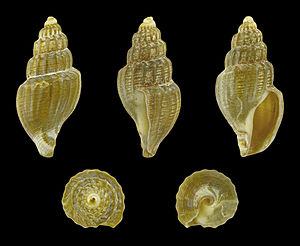Stepped gable
| Stepped gable | ||||||||||||
|---|---|---|---|---|---|---|---|---|---|---|---|---|

Stepped gable, west beach of Sylt |
||||||||||||
| Systematics | ||||||||||||
|
||||||||||||
| Scientific name | ||||||||||||
| Propebela turricula | ||||||||||||
| ( Montagu , 1803) |
The stepped gable ( Propebela turricula ), also known as the Kleine Stairenschnecke or Kleine Lora ( synonyms : Lora turricula , Oenopota turricula and Bela turricula ), is a snail from the family of the Mangeliidae , which, like the related cone snails, belong to the arrow tuckers ( Conoidea ). The snail eats many bristles , which it harpooned with its radula teeth .
distribution
The animal is found on soft soils in the permanent flood zone of the Atlantic and its side seas, the English Channel , the North Sea and the Baltic Sea .
It lives at depths of 20 to 270 meters on sandy and silty bottoms, on sandbanks with the many- bristled Sabellaria .
Appearance
The stepped gable has up to eight clearly separated passages, the mouth of the housing is long and club-shaped, with a short siphon channel . Broad axial ribs and delicate spiral ribs can be seen on the surface of the shell of the 1.8 cm high snail. The animal's casing is white, yellow, brown, sometimes even almost gray.
Development cycle
In contrast to most of the known Conoidea, the stepped gable is a protandric hermaphrodite, i.e. first male and then female. Internal fertilization takes place, and the female lays egg capsules from which free-swimming Veliger larvae hatch with just one - the right - antennae. These metamorphose into crawling snails only after a pelagic phase.
food
The stepped gable is like all arrow tongues a predatory snail , the radula of which is studded with poisonous teeth. This gives her the opportunity to paralyze and then kill her victims - tiny annelids . Was in as prey Sound of polychaete (polychaete) Spiophanes bombyx from the family Spionidae observed.
literature
- George Washington Tryon: Manual of Conchology, structural and systematic, with illustrations of the species , vol. VI; Academy of Natural Sciences, Philadelphia 1884. B [ela] turricula Montagu, p. 219.
Individual evidence
- ↑ Erwin Stresemann (Ed.): Excursions fauna. Invertebrates I. SH Jaeckel: Mollusca . Volk und Wissen, Berlin 1986. S. 134. Lora turricula (Montagu).
- ^ Edmund H. Smith (1967): The reproductive system of the British Turridae (Gastropoda: Toxoglossa). The Veliger 10 (2), pp. 167-187.
- ↑ Karen V. Vestergaard (1935): On the spawn and larvae of Scalaria communis (Lam.), Nassarius pygmaeus (Lam.) And Bela turricola (Mont.). Zoologischer Anzeiger, 109, 217-222. [Note: Bela turricola is synonymous with Propebela turricula .]
- ↑ Vera Fretter, Alastair Graham (1984): The prosobranch molluscs of Britain and Denmark. Part 8, Neogastropoda. Journal of Molluscan Studies, Supplement 15, pp. 435-556, here p. 514.
- ↑ Anders Eliason (1920): Biological-faunistic studies from the Öresund. V. Polychaeta. Lunds Universitets Årsskrift 2 (16), pp. 1–103, here p. 147.
Web links
- Marine Species Identification Portal, Mollusca of the North Sea: Oenopota turricula (Montagu, 1803)
- Poisonous harpoon tooth from Oenopota turricula (on the Things with Stings page , reefkeeping.com)
- World Register of Marine Species , World Marine Mollusca database: Propebela turricula (Montagu, 1803)